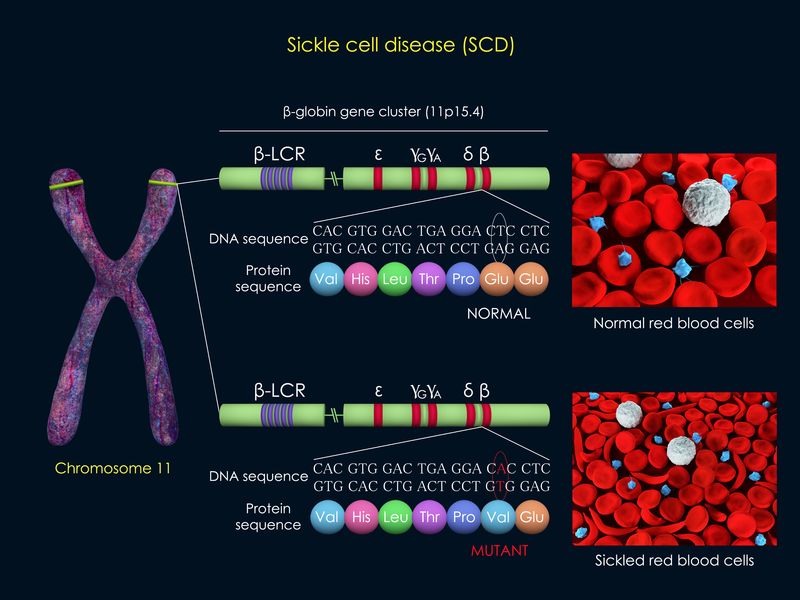FDA Approves Adakveo (crizanlizumab-tmca) to Reduce Frequency of Pain Crises in Individuals Living with Sickle Cell Disease

Basel, November 15, 2019 – Novartis announced today that the US Food and Drug Administration (FDA) approved Adakveo (crizanlizumab), previously known as SEG101, to reduce the frequency of vaso-occlusive crises (VOCs), or pain crises, in adult and pediatric patients aged 16 years and older with sickle cell disease.4 Adakveo represents the first FDA-approved medicine in sickle cell disease that binds to P-selectin –a cell adhesion protein that plays a central role in the multicellular interactions that can lead to vaso-occlusion.5,6 The medicine is expected to be available to patients in the coming weeks.
The FDA’s decision to approve Adakveo 5 mg/kg is based on results of the 52-week, randomized, placebo-controlled SUSTAIN trial, which showed that Adakveo significantly lowered the median annual rate of VOCs to 1.63 vs 2.98 compared to placebo (P=.010), which is equivalent to a 45% reduction. Reductions in the frequency of VOCs were observed among patients regardless of sickle cell disease genotype and/or hydroxyurea use.2,4
“We know this drug can decrease the frequency of sickle cell pain crises in a significant and clinically meaningful way,” said Kenneth Ataga, MD, Director, Center for Sickle Cell Disease, University of Tennessee Health Science Center at Memphis, and Principal Investigator of the SUSTAIN trial. “The approval of crizanlizumab is an important advancement for people living with this very difficult condition.”
Additional results from the SUSTAIN study include:4
- A decrease in the median annual rate of days hospitalized to 4 vs 6.87 days when compared with placebo (a 42% reduction)
- Thirty-six percent of patients treated with Adakveo did not experience a VOC, compared to 17% of placebo-treated patients
- The median time to first VOC was 4.1 for Adakveo vs 1.4 months for placebo
The most common adverse reactions (incidence > 10%) were nausea (18%), arthralgia (18%), back pain (15%) and pyrexia (11%).4
“The approval of Adakveo marks a new era in the treatment of sickle cell disease, a genetic condition that places an extraordinary burden of unpredictable pain crises on patients and their families,” said Susanne Schaffert, PhD, President, Novartis Oncology. “The stories we have heard from patients about their sickle cell pain crises are devastating. We are pleased to help reimagine medicine together with the sickle cell community and offer new hope for fewer VOCs.”
Considered the clinical hallmark of the disease, sickle cell pain crises are triggered, in part, by multicellular interactions that form clusters of cells, which can block or reduce the blood flow to organs.1,7 Sickle cell pain crises can be frequent and sudden, and are associated with an increased risk of life-threatening complications.1 They also are the main reason why individuals living with sickle cell disease go to the emergency room and are admitted to the hospital.7
"Patients with sickle cell disease often face unique challenges, and have long suffered silently through unimaginable pain crises,” said Beverley Francis-Gibson, President and CEO of the Sickle Cell Disease Association of America. "We are excited to have a new medicine that may help many of the thousands of people living with sickle cell disease by reducing the frequency of these potentially dangerous and painful episodes."
About Sickle Cell Disease
Sickle cell disease is a complex and debilitating, genetic blood disorder that goes beyond sickle-shaped red blood cells. The disease is associated with chronic inflammation, causing higher levels of cell adhesion proteins, including P-selectin, which make both the blood vessels and certain blood cells stickier and prone to multicellular interactions, or clusters, in the bloodstream. This environment can lead to the acute episodes of pain known as sickle cell pain crises, or VOCs, as well as life-threatening complications.1,7,8 VOCs are the main reason why individuals living with sickle cell disease seek medical care in hospitals,7 leading to approximately 200,000 ER visits in the US every year.9,10
Approximately 100,000 people in the US have sickle cell disease.3 People of African ancestry make up 90% of the population with sickle cell disease in the US. However, sickle cell disease is also prevalent among people of Hispanic, South Asian, Southern European, and Middle Eastern ancestry. Sickle cell disease occurs in about 1 in 365 and 1 in 16,300 African-American and Hispanic-American births, respectively.3
About Adakveo
Adakveo (crizanlizumab) – previously known as SEG101 – is indicated to reduce the frequency of VOCs, or pain crises, in adults and pediatric patients aged 16 years and older with sickle cell disease. It is the first and only targeted biologic that works by binding to P-selectin, a cell adhesion protein that plays a central role in the multicellular interactions that can lead to vaso-occlusion in sickle cell disease.
By binding to P-selectin on the surface of the activated endothelium and platelets, Adakveo blocks interactions between endothelial cells, platelets, red blood cells, and leukocytes.4 (Article from : www.drugs.com)

